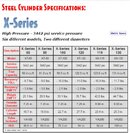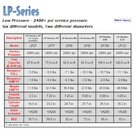Leadking
Contributor
I am late to the party but post the following comments for U.S. based cylinders:
There is only one true HP cylinder, the Luxfer hoop wrapped aluminium cylinder rated at 4350psi
Consideration of LP, <2400psi or, what we call HP >3130psi, considering that 3500psi cylinders are no longer manufactured for the U.S. market, should be based on the following:
Height of the cylinder, a tall cylinder may affect your mobility and center of gravity
Diameter of cylinder, a larger diameter will affect your center of gravity
Availability of proper fills to rated pressure
Buoyancy characteristics of the cylinder, generally HP steel are more negatively buoyant. Be careful not overweight yourself, and carry some lead to gain positive buoyancy in an emergency.
Gas needs for your particular diving activities.
Pressure ratings of your regulators
All of these items need to be considered when making a cylinder purchase, as one size does not fill all.
Good diving,
Lee
There is only one true HP cylinder, the Luxfer hoop wrapped aluminium cylinder rated at 4350psi
Consideration of LP, <2400psi or, what we call HP >3130psi, considering that 3500psi cylinders are no longer manufactured for the U.S. market, should be based on the following:
Height of the cylinder, a tall cylinder may affect your mobility and center of gravity
Diameter of cylinder, a larger diameter will affect your center of gravity
Availability of proper fills to rated pressure
Buoyancy characteristics of the cylinder, generally HP steel are more negatively buoyant. Be careful not overweight yourself, and carry some lead to gain positive buoyancy in an emergency.
Gas needs for your particular diving activities.
Pressure ratings of your regulators
All of these items need to be considered when making a cylinder purchase, as one size does not fill all.
Good diving,
Lee





